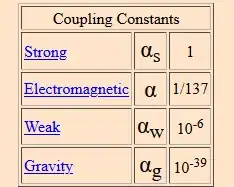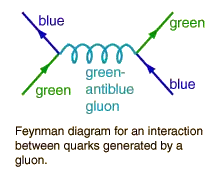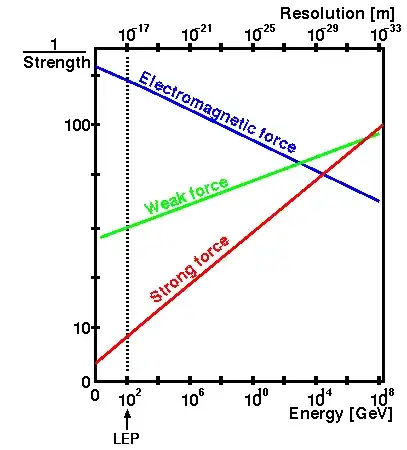I have heard that the strong force can be imagined similar to a rubber band, where the farther you extend the ends, the harder they pull themselves back together. My question is how? From what it looks, the strong force is pretty similar to the electromagnetic, just that its exchange particles also carry a charge, so why does its range to strength relationship differ so radically? What occurs during the exchange of gluons that creates this rubber band effect?
4 Answers
The fact that gluons can interact with gluons, while photons do not interact with photons, makes a huge difference. As a result of these gluon interactions, gluons can spawn additional gluons. The attraction between color particles does not fall off with distance in the way it does for electrically charged particles. The energy that one must spend to separate two colored particles produces more and more gluons. Thus the energy increases linearly with separation distance, up until there's enough energy to create a particle-antiparticle pair of colored particles. For this reason the color charge is confined. One can never separate a single color charged particle from other colored charged particles.
Hope this answers the question. Otherwise, a more specific explanation of the issues may help me to clarify it further.
- 16,824
Exchange particles are a part of a quantum field theory model.The specific quantum field theory for particles is the standard model of physics, and you are correct, there are mathematical similarities between the strong force and the electromagnetic force.
Here are the coupling constants of the four interactions that at the moment are accepted as the only ones needed to describe the data.
All calculations of the standard model are in series expansion, the coupling constant multiplicative in higher powers in front of each consecutive term. These terms are pictured by Feynman diagrams, and that is where the term "exchange particle" comes from.
Here is the strong force at lowest order:
and here the lowest order for the electromagnetic
The difference is that for the electromagnetic, the lowest order is good enough to fit the data within experimental errors, most of the time.
But, because the coupling of the strong force is 1, all orders in the expansion are equivalent, so in mathematical reality the expansion is meaningless because it would add up to infinity. This is what is meant that the self interaction of gluons create a very strong force: because the coupling constant is 1. ( the gravitational coupling is very small so, even though the graviton also has self interaction, it cannot add up to a strong force. The gravitational self coupling is being researched, for example )
Even though the group theoretical part of the model is validated by the data, and the way hadrons are made up by quarks, color , etc etc agree with observations, a non perturbative model is needed to model, get numbers out of, the strong force. This is QCD on the lattice which is at the research stage still.
Title asks:
How does the strong force increase in attraction as particles move farther away?
I have not been through the math, but qualitatively it seems reasonable that the further away two color particles are the more diagrams could contribute
This talk describes in parallel electromagnetic and strong interactions.
- 19,613
- 236,935
There is a nice answer by @annav, I believe I would like to add something that is still missing from all the answers. You say rubber band, I say gluon flux tube and asymptotic freedom.
Gluons have this phenomenal ability, they can create these linear structures called flux tubes. None of the other force carriers can do this. The photon at normal energy levels is not even self interacting, nor does it carry EM charge. The hypothetical graviton is self interacting, and it does carry gravitational "charge" (stress-energy), but it still can't do what the gluons.
You are interested in the expression "constrain color fields to string like objects". Now gluons are special because there are different types of them (with different color charges). There is only one type of photon or graviton. Gluons can and do interact at normal energy levels and because of the tricolor system, they can stick together in linear objects (tubes). Now there is something we call the static EM field, static gravitational field, and those spread (disregard EM shielding) spherically. If there are two electrons, the EM interaction between them is modeled using their static fields (modeled in a spherical form). Same for gravity. None of these forces can create interactions where we can model the interaction using a linear (string-like) structure in between. Only in the case of the strong force can we model the two confined quark's interaction using a string like form (flux tube).
When you try to separate two confined quarks, what happens is that the color force that is mediated between them by gluons, stays strong, and gluons create this thing called the flux tube.
These gluon-gluon interactions constrain color fields to string-like objects called "flux tubes", which exert constant force when stretched. Due to this force, quarks are confined within composite particles called hadrons. This effectively limits the range of the strong interaction to 1×10−15 meters, roughly the size of an atomic nucleus. Beyond a certain distance, the energy of the flux tube binding two quarks increases linearly. At a large enough distance, it becomes energetically more favorable to pull a quark-antiquark pair out of the vacuum rather than increase the length of the flux tube.
https://en.wikipedia.org/wiki/Gluon
It is a real phenomenon, that no other force (carrier) is able to do, and it is a real linear structure between the two confined quarks. When you try to separate the quarks more, then you add energy to the system. Oops. You just created more gluons in between, and made the flux tube longer. But the binding energy stays.
How far can we separate two bound quarks?
You can do this and make the flux tube longer, until you reach about 3 fermi. At that point it becomes energetically more favorable to create quark antiquark pairs in between the original quarks. Oops. You just created more confinement. You just can't get out of this confinement can you. Well, yes you can. I mentioned asymptotic freedom. At certain energy levels, when the quarks are closely packed, the quarks and gluons become free and you get a quark gluon plasma.
Beyond the normal phase of QCD (at extreme temperatures and pressures), quark–gluon plasma forms. In such a plasma there are no hadrons; quarks and gluons become free particles.
If quarks can't be isolated in the first place, how did they become confined in the early universe?
So the ultimate answer to your question is that gluons are phenomenal, because they can create flux tubes.
- 30,008
If your question is why the strong force is the way it is, then this is hard to answer as physics is really concerned with how things happen. And I guess that one possible answer to why, is that experiments show that nature does not like particles that have a fractional electric charge. Electric charge is always either zero, or some positive or negative integer multiple of the electron charge.
If we do experiments using high energy collisions on hadrons to "separate quarks", a quark-anitquark pair is formed instead. This is simply the nature of the strong force.
The differences between the electromagnetic force and the strong force is that quarks carry an additional quantum number called colour, also called “colour charge”. If two quarks interact with each other, they exchange gluons, which carries or mediates the colour force (the strong force).
We know that gluons are the exchange particles (analogous to photons in the electromagnetic force) which carry the strong force between quarks in the same way that photons are the exchange particles between charged particles (electrons, positrons) which carry the electromagnetic force.
But unlike photons that do not carry electric charge, gluons carry colour charge. This means that as gluons interact with quarks, they exchange this colour charge. Quarks combine to form hadrons (eg baryons and mesons). But we can never isolate single quarks due to quark confinement. As stated above, when we try to put a large enough amount of energy to separate the quarks, we end up with the creation of other quark groups (mesons). This is because the energy when we attempt to separate quarks exceeds the energy needed for pair production or quark-antiquark pair creation.
Analogously, in the electromagnetic interaction, a photon of sufficient energy can create an electron-positron pair if the initial photon energy exceeds the energy of the pair.
- 31,821



